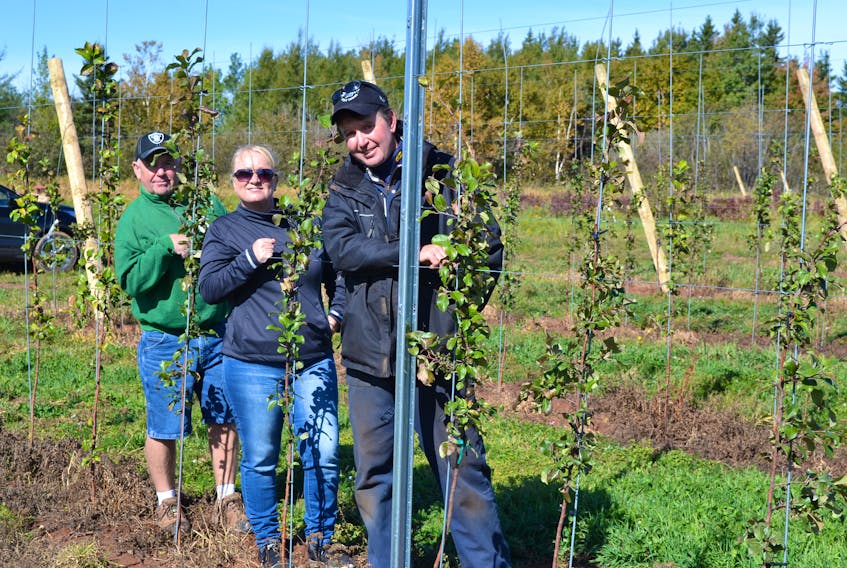CHRISTOPHER CROSS, P.E.I. - As he scans his 31 rows of first-year apple trees growing on trellises in an eight-acre field, John Handrahan is both optimistic and satisfied.
“They did rather well, considering they got almost no rain for eight weeks,” he said during an open field day in Christopher Cross on Friday.
With approximately $150,000 invested in 6,000 trees and their supporting infrastructure, Handrahan needs his high-density orchard to prove wrong the naysayers who suggest the climate in western P.E.I. is not conducive to commercial apple production.
To do so, he went with 80 per cent Honey Crisp and 10 per cent each of Gala and Ambrosia apple stock.
Clearly, his hope for a productive orchard rests largely on the Honey Crisps, but they do require the cross-pollinators so that the springtime bees can really work their magic.
While only about five acres of the field is in production, as the rest of the field is taken up with wet spots, Handrahan, a veteran blueberry grower, sees good potential in his small acreage orchard.
Three strands of high tensile wire is stretched from wooden support posts securely anchored at the ends of the rows. There are metal support posts placed at intervals along the rows, and a vertical metal rod driven beside every tree and secured to the horizontal wires. Trees, planted every two and a half to three and a half feet, are fastened to the rods as they grow. As they fill out they create a wall.
Handrahan’s been consulting with Tim Pearson and Nancy MacKay, co-owners of Red Shore Orchards, since attending a high-density apple orchard presentation in March, 2017. They obtained the root stock for his orchard and helped plant the trees and install the trellis system in June.
Pearson, whose family still owns orchards in Nova Scotia, said Honey Crisps are a good fit for the climate.
“You like to see the odd frosty night around early September,” he said. “Those warm days and cool nights really help the finish come along.”
Warm days and cool nights, the type of climate Handrahan is accustomed to, helps throughout the growing season, MacKay said.
With the Northumberland Strait close by on one side of him and the Gulf of St. Lawrence on the other, Handrahan said the marine effect makes for cooler temperatures early in the growing season, but he said that same marine effect helps keep the temperature up later into the fall, so it evens out. Handrahan’s also banking on the cooler start delaying the blossom period until harmful spring frosts have ended.
Pearson said prices for Honey Crisps have remained strong. He said growers received $600 to $700 per bin of Honey Crisps the last couple of years. He said Handrahan’s trees should be producing fruit by 2021 and be in full production, with 75 to 100 apples per tree, by 2024-2025. At just $500 a bin, he said Handrahan should be able to recover his initial investment by year six or seven.
“It’s pure profit after that, minus your operating costs,” said MacKay.
Pointing to room for growth, she said Canada’s apple production only supplies 25 per cent of its domestic market.
Handrahan said there is plenty of room, even in the Ontario market, for Maritime-grown apples.
Red Shore Orchards owners estimate there are now about 400 acres of high-density orchards in P.E.I. and room to grow. They are encouraged about a perennial crop program the provincial government introduced this year but suggest tweaking is needed so that interested growers can take full advantage of it when they put their deposit down for nursery stock.
MacKay said start-up costs are small in comparison to getting into potatoes or dairy.
“If you have some land available, you don’t have to have it all in one product. You can start off small with just five acres,” she suggested. “It’s pretty manageable for a family to do.”









